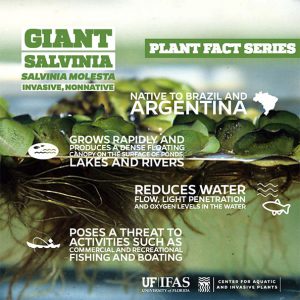Giant salvinia (Salvinia molesta) is an invasive floating fern from South America that prefers to stack up in slow moving water. Trust me, I know that is a really strange sentence – so let me explain. Being a fern, this plant does not form flowers or seed. This plant’s reproduction is more primitive, and it forms spores instead of seed. Giant salvinia reproduces by fragmentation – basically meaning one plant becomes two. As this little fern grows and divides, the populations can quickly become overwhelming. As it reproduces, the plants begin to stack up on itself and form thick layers on the water. In some locations, giant salvinia has been documented to be over 3-feet thick!

What harm does this really do? Don’t aquatic plants add oxygen to the water? The answer to this is…it depends. Submersed plants (those rooted in the sediment and growing completely underwater) release oxygen during photosynthesis, this oxygenates the water. However, floating plants do not do this. They release oxygen too, but since they float all the oxygen goes into the atmosphere. Instead of adding oxygen to the water, they dramatically reduce it in three ways. First, the thick mats totally shade out the submersed plants and photosynthesis stops. Second, the mats prevent wave action, which is a major source of oxygenation. Third, with time the fronds decay and drop into water creating a layer of muck on the waterbody floor. As microbes break down the detritus, more oxygen is consumed and can lead to total depletion. So, highly aggressive plants like giant salvinia can devastate aquatic ecosystems by crowding or shading out desirable plants while depleting oxygen and creating unsuitable conditions for fish and other aquatic species.
In Louisiana and Texas, giant salvinia is a devastating issue. Thousands of acres have been infested by this half-dollar sized plant and efforts to get it under control have been akin to walking on a treadmill – a lot of effort expended without making forward progress. Therefore, Florida stays on the lookout for this nasty little invader. Currently, only four sites in the state are known to have giant salvinia and each of these are under full-scale eradication plans. Fortunately, our regulatory agencies caught the infestations early and each site is well under one acre in size. Considering the small size and few locations, it is possible we can beat this plant and prevent the issues being faced in Louisiana and Texas. However, we must remain on the offensive.
Giant salvinia is a cool and funky little plant that looks great in aquariums and water-gardens. On the other hand, it is also an ecosystem engineer that can dramatically alter an aquatic resource if released into the environment. It is critically important we not move plants like giant salvinia around from state to state. If these plants continue to be imported and released, it might just become our next major problem.
For more information on how giant salvinia has impacted other states, watch this short video: There’s Something in the Water
Dr. Jason Ferrell, UF/IFAS CAIP Director, wrote this piece. Any questions should be directed to Shelby Oesterreicher at soesterreicher@ufl.edu. For more information about the UF/IFAS Center for Aquatic and Invasive Plants, please visit http://plants.ifas.ufl.edu. Be sure to follow us on social @UFIFASCAIP.
UF/IFAS CAIP, Turning Science Into Solutions.
 0
0
